On a Monday late in April 2020, the tiny, rocky, sparsely populated Norwegian island of Smøla, which had been sealed off from the outside world for three months, reopened its one point of access, a ferry terminal that connects it to the coastal cities of Trondheim and Kristiansund. The move brought joy to the residents of Smøla, who often travel to the mainland for supplies and recreation. It also gladdened tourists and adventurers, particularly those with an interest in the fabled land of Thule, also known as ultima Thule, whose exact location in the world has been debated for over two millennia. According to one recent school of thought, Smøla is the island with the strongest claim to that location: reopening Smøla thus meant that it was once again possible to set foot on Thule.
Thule’s enigmatic and complicated history begins in the fourth century BCE, when the ancient Greek explorer Pytheas left the port city of Massalia—now Marseille, France—in search of new trading opportunities in the Far North. Pytheas and his commercial backers had a special interest in finding amber, used as a form of currency, as well as tin, a key ingredient in manufacturing bronze. Sailing at first west, then north, Pytheas arrived at and mapped the coastline of Prettanikē—now the British Isles—and then boldly headed farther north into uncharted territory. And there the journey entered an unworldly realm. After a few days’ sail, Pytheas reached a place he described as neither earth nor sea, “but instead a sort of mixture of these similar to a marine lung, in which the earth and the sea and all things together are suspended, and this mixture is … impassable by foot or ship.” Pytheas landed nearby, on an island whose name he heard as Thule [TOO-lee]. Eventually he returned to Massalia and wrote his masterwork, On the Ocean, an account of his voyage and a treatise of enormous influence in the ancient world.
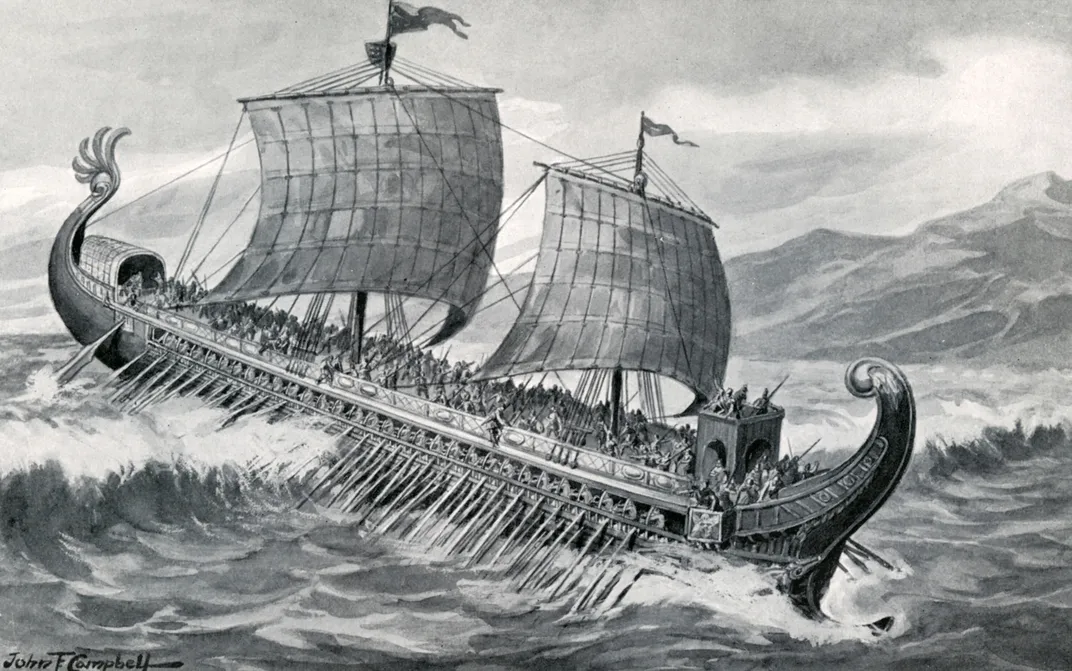
Unfortunately, like so many other ancient masterworks, the copy of On the Ocean meant to be preserved for posterity was lost when the great library at Alexandria burned down in 48 BCE. No other copy—presumably there were other copies in Marseille and elsewhere—has survived. All that is known of On the Ocean comes from a small and somewhat random set of quotes and paraphrases passed along by later geographers and historians like Strabo (early first century BCE) and Pliny the Elder (later in the same century).
These snippets of text seem to confirm that Pytheas actually had discovered a strange island in the remote Far North, in fact the remotest Far North of the known world—thus the adjective ultima, meaning “most extreme,” attached to it by the Roman poet Virgil. But where exactly was the island? No other explorer had returned to it in the centuries between the discovery and the destruction of the library. As a result, Strabo, Pliny, and other writers could only guess at Thule’s true location. Their speculation initiated a whole branch of Thule scholarship and exploration, all aimed at finding the place Pytheas had so intriguingly described. And as century after century went by without a definitive answer, Thule attained a kind of mythic stature. From the first century CE onward, Thule became more of an idea than an actual place, an abstract concept decoupled from the terrestrial map, simultaneously of the world and otherworldly. Poised at the edge of the known and inhabited Earth, it functioned as an emblem of mystical isolation, liminal remoteness, a real discovered place and yet unknown: “Out of SPACE—Out of TIME,” to quote Edgar Allan Poe in one of the countless literary allusions to the enigmatic island.
***
Few places on Earth have been the subject of as much controversy, wrote the German historian Martin Ninck in 1945, referring to the search for Thule. The controversy arises from the thinness of the evidence—mostly just those scant surviving fragments from On the Ocean. The clues point in certain clear directions while leaving open a broad range of possibilities. Over the years, Iceland, Greenland, the Shetland Islands, the Faroe Islands, Saaremaa (an Estonian island), and islands along the north coast of Norway have all been viewed as contenders.
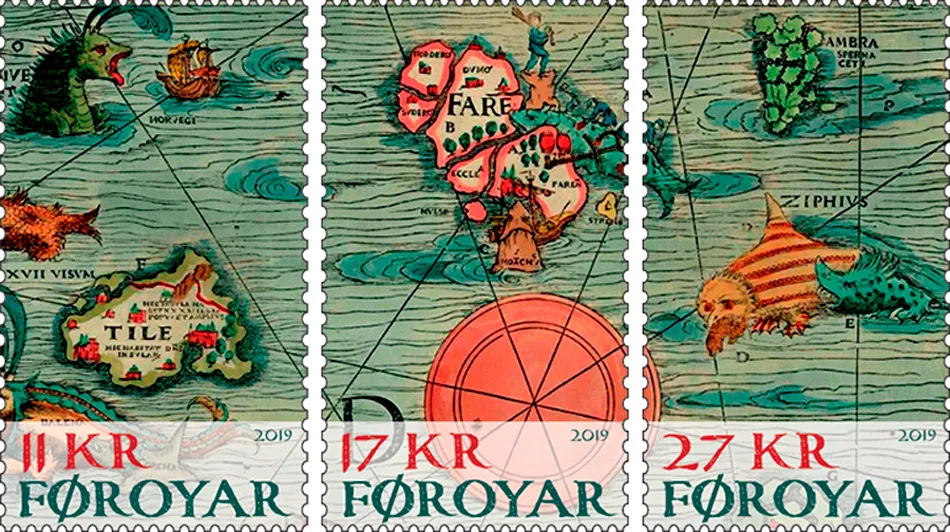
Since the early 20th century, though, two schools of thought have dominated the debate: that Thule is Iceland, and that it is Norway. The arguments for each side are compelling, yet the evidence is so ambiguous that for every plausible claim, the other side has forcefully advanced a counterclaim. Consequently Norway versus Iceland, as a scholarly debate, often looks very much like a stalemate, impossible to break.
The debate received a jolt, though, in 2010 with the publication of a study out of the Technical University of Berlin. The authors, two geodesists (geodesy is a branch of applied mathematics focused on maps and measurements), an expert in the study of Greek and Latin texts, and a historian of science, took an innovative approach. They began with the famous map of the oikoumenē—the ancient Greek name for the inhabited world—drafted by the second-century CE geographer Ptolemy. Although the map was sophisticated for its time, its coordinates were problematic, partly because of deficits in Ptolemy’s understanding of projection, partly because of errors in measurements of distances. The German team addressed the problems through reconstructionist geodesy, a method of detecting the errors accurately and correcting them systematically. The novel approach led to a solution striking in its precision. And to a happy, if surprising, outcome for everyone who favored Norway. Thule, according to the team, almost certainly must be the island of Smøla, a locale farther to the south than any of the Norwegian islands that had been on the longlist of contenders.
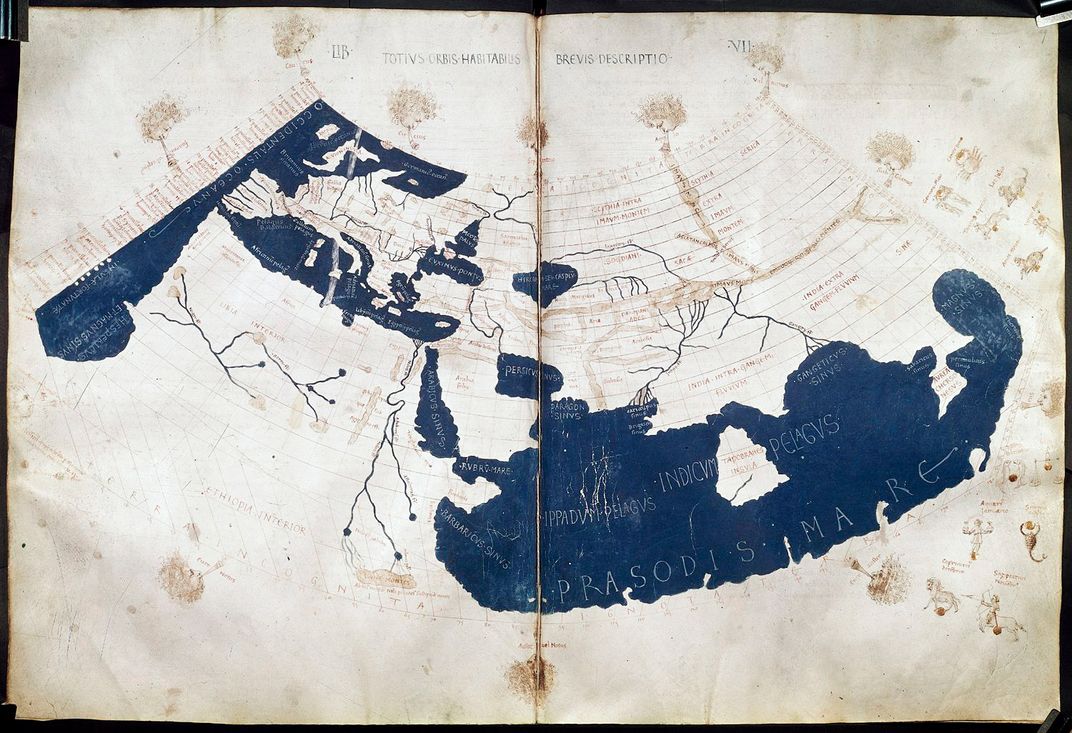
The confidence of the researchers in their finding can be seen plainly in a letter from the team leader, Dieter Lelgemann, to a journalist in Smøla in 2008, following a press release that announced the team’s in-progress discovery: “As about this old information there cannot be any doubt anymore,” he wrote. “You live on the mystic island of Thule, and this can of course be interesting for all tourists.”
***
On the mystic island, the reaction was generally enthusiastic. Many of Smøla’s 2,000 permanent residents saw an opportunity. For the past few decades, the focus of the island’s tourism marketing had been sportfishing and wildlife tours, primarily for European and domestic markets. To be identified as Thule potentially opened up a much wider realm of tourist interest, international in scope. Before long, ideas for Thule-inspired merchandise entered into the picture: T-shirts, caps, jigsaw puzzles of antique maps, models of Greek merchant vessels. A marketing logo was designed that featured a ship sailing toward a midnight sun skimming the horizon in midsummer, just as Pytheas had described the sun in On the Ocean.
The sanguine view of an influx of Thule tourists has its roots in historical precedent, as tourists have been curious about Pytheas’s voyage for centuries. The Dutch historian and artist Jan Huyghen van Linschoten, for example, born in 1563, traveled to Norway’s North Cape to sketch landscapes of a coast that at the time stood among the contenders. In the 19th century, Thomas Cook & Son, forerunner of the late Thomas Cook Group, arranged tours to the North Cape and nearby islands and advertised them as journeys to an Arctic wasteland discovered by the ancient Greeks. And solo or small teams of adventurers set out on quests for Thule, including the renowned polar explorers Vilhjalmur Stefansson (the discoverer of several islands in the Canadian Arctic Archipelago) and Fridtjof Nansen (the first to cross the Greenland ice cap and later a Nobel Peace Prize laureate).
Then there are the Thule voyagers of the present, the tourists who pay homage to the statue of Pytheas in Marseille, or visit the Thule Bar in Lerwick on the Shetland Islands, or run in the annual ultima Thule marathon on Saaremaa, or leave their jobs to chase Thule clues and write about them, as Joanna Kavenna did in the much-lauded 2006 book, The Ice Museum: In Search of the Lost Land of Thule.
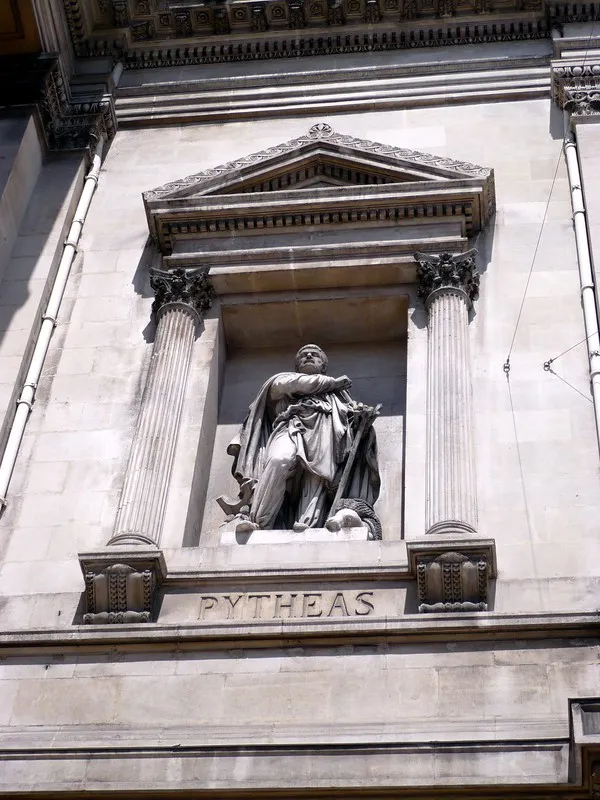
It’s not, though, as if even the most optimistic Smøla residents expected throngs of tourists. The interest in Thule has always been driven by a somewhat esoteric curiosity. None of the polar explorers or amateur adventurers who set out in search of the actual Thule were motivated by material or commercial interests. The search for Thule has been purely a search to solve a mystery, unlike, say, the search for the Northwest Passage as a European trade route to Asia. An abstruse mystery; still, even a slight boost to tourism makes a difference to a small island like Smøla that relies heavily on tourism revenue.
Making Smøla a Thule tourist destination has long been on the mind of Ernst Olav Blakstad. If anyone on Smøla knows Thule’s complex history, it’s this affable, exceptionally knowledgeable master mariner whose work has taken him across many of the same northern oceans traversed by Pytheas. He’s stocky, with the broad shoulders and muscular forearms of someone who could wrestle a thrashing shark into submission. From the second floor of a pub in Dyrnes, a village in the northwest corner of the island, he points out a house built by his grandfather and originally used for storing cod and repairing fishing nets. His uncles and father built a bigger structure for making nets and trawls; that building is now the pub we’re sipping coffee in. “My family has fished for cod from this island for four generations,” he says. He’s proud of the deep tradition, but thinks that for tourism to gain traction, it needs to be bold. “We need to think bigger,” he says. “We need to look beyond our fishing history, toward our rightful place in the major discoveries of the ancient world. We are a major discovery.”
And in fact, in the last few years, under the leadership of Einar Wikan, Smøla’s official business manager for the community, an assortment of new programs has been implemented to aggressively court tourism beyond the seasonal staple of sport fishers and wildlife viewers. Blakstad feels confident that in the expanded tourism scheme, Smøla’s identification as Thule will play a key role. “Thule tourists are dedicated people, searching for knowledge.”
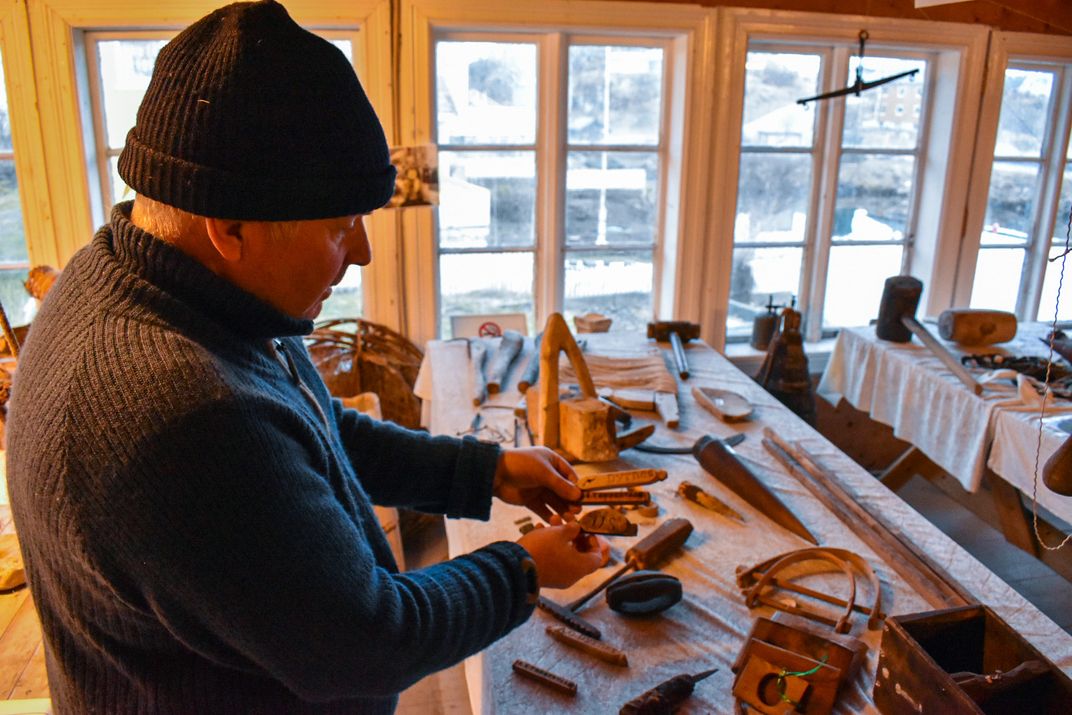
For the less hardcore of the Thule searchers, however, Smøla-as-Thule has proved so far to be a hard sell. Hurtigruten, a major cruise line in the region, advertises the opportunity to “travel in the footsteps of the ancient Greek explorers,” but the nearest its cruises come to Smøla are stops at Kristiansund and Trondheim, still some distance (in the former case, two ferries and a bus) from the beach where the most famous of the Greek explorers may well have set foot. Lindblad Expeditions’ fleet of adventure cruise ships, including the National Geographic Explorer, has been making regular stops at Smøla, but most of the passengers who disembark have come to see the wildlife—Smøla has one of the densest concentrations of white-tailed eagles in northern Europe—or to tour the quaint fishing village of Veiholmen, at the far northern end of a long spit of land at the island’s northeast corner.
The difficulties in courting Thule tourists were summed up in a conversation with Jonathan Zaccaria, an expedition leader for Lindblad Expeditions who’d brought a group of adventure tourists to Smøla in 2018 aboard the National Geographic Explorer. After the Explorer put in, Blakstad, who occasionally gives Thule-oriented tours and talks, showed the group around the late–Iron Age fishing villages of Brattvær and Odden, but the passengers were restless. They wanted quaintness. They spent half of their day on Smøla in Veiholmen, the epitome of quaintness, with its fetching oceanfront kaffeebarer (coffee bars) and white clapboard houses bearing names from the era when Veiholmen built a new, more sheltered harbor: a tourist favorite is Latræva—lazy asses—marking the property to which the less diligent of the harbor excavators would retreat for unsanctioned breaks.
In the end, Zaccaria hadn’t been impressed: even with charming Veiholmen, Smøla considered as a whole was just too desolate, in his view, Thule or no Thule, to justify a cruise stop. “The countryside of the countryside” was how he characterized Smøla as a Thule destination in comparison with, say, Reykjavík on Iceland. And in fact, according to Zaccaria when we spoke in January, Lindblad had recently reviewed its upcoming expeditions and crossed Smøla off the list as, on balance, unworthy. Lindblad declined to confirm or deny, but in any case, for at least the summer 2020 cruising season, the point is moot, as most of Norway’s cruises have been put on pause on account of the coronavirus pandemic. No small loss, as the cruises contribute massively to western Norway’s economy.
***
Another obstacle to leveraging the German team’s discovery as a means of boosting Smøla’s Thule tourism lies in the enormity of the history of the search for Thule. The history goes back so far, and so many voices have weighed in over the centuries, that even as innovative and confident a claim as that of the German team can at best take its place in the debate, its geodesic evidence stacked up against all the rest.
The view that Thule is Iceland, for example, remains influential. Foremost among the advocates of Thule-is-Iceland is Barry Cunliffe, author of The Extraordinary Voyage of Pytheas the Greek and a professor emeritus at Oxford University who taught European archaeology for 36 years. Cunliffe defends the Iceland position one morning in the café of the Ashmolean Museum in Oxford. In many ways, Cunliffe is Blakstad’s scholarly counterpart, the defender of Iceland, as Blakstad is of Smøla. Cunliffe in his thick wool sweater looks like he, too, would be at home at the helm of a fishing trawler. It’s easy to imagine Blakstad and Cunliffe squaring off in friendly yet forceful debate over black coffee in some North Sea port tavern.
At the Ashmolean, with his notes spread on the table in front of him, Cunliffe sketches a plausible scenario for Pytheas’s route to Iceland. “Imagine you’re a seafaring people,” he says, referring to the early inhabitants of what is now the northern British Isles, “and every year you see birds migrating to the north. Where are they migrating to? Land must be out there, beyond the horizon. Eventually curiosity—the human desire to acquire knowledge—drives you northward to explore.” It would have been those explorers, Cunliffe argues, who first discovered Thule, and who led Pytheas there.
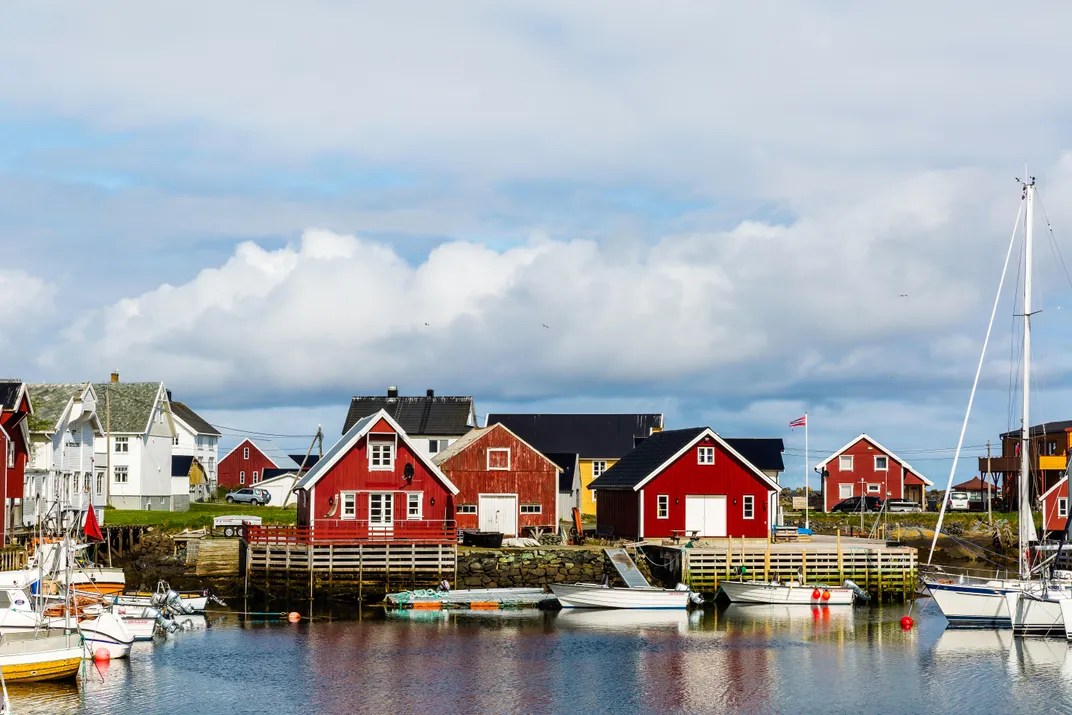
But what about the honey and the mead, two famously contested points in the Thule mystery? In a fragment from On the Ocean, Pytheas wrote, or seems to have written, that his hosts on Thule subsisted by cultivating herbs and fruits, and that they made a drink from grain and honey: mead. Advocates of Thule-is-Norway seize upon this point as definitive. Iceland, they say, almost certainly wasn’t inhabited at all until well after Pytheas made his voyage, while on Smøla there are archaeological finds suggesting that Bronze Age settlers farmed, kept bees, and drank mead.
“Ah, the mead,” says Cunliffe. “The Pytheas fragment is a bit vague. It doesn’t actually include the name ‘Thule.’ It may refer to some unspecified people in the north, not specifically the inhabitants of Thule.”
And so our conversation goes, Cunliffe addressing each of the points of the debate in turn, ending on a note of cheerful uncertainty. Did he think it possible that a full copy of the lost manuscript of On the Ocean might turn up one day behind a wall in a monastery or a Marseille chateau, and settle the issue once and for all? Never say never, he says, adding that he predicts the Thule debate will continue in perpetuity. (Though he’s aware of the German team’s work, he professes not to be enough of an expert in geodesy to want to offer an opinion.)
Before we part, Cunliffe adds that if someone gave him £1-million in funding to put to whatever use he wanted, he would go digging in the peat in the north of Iceland in search of Bronze Age human settlements; at present, the generally accepted date for the settlement of Iceland isn’t until about the ninth century CE. Such proof would, at the very least, silence the Norway boosters who endlessly bring up Iceland’s emptiness in Pytheas’s time as a fatal blow to the Iceland argument.
***
To approach Smøla by boat is potentially treacherous—much of the island’s coastline is studded by thousands of rocky islets, some as small as huts, that jut from the sea like mini icebergs. More than 6,000 have been mapped, and then there are the countless fluer, rock formations that become submerged and perilous at high tide. Over the long span of time that Smøla prospered with a cod fishery—its first fishing villages were settled in the early 14th century—many fishing craft ran aground in bad weather on the islets, and many lives were lost. At the center of Veiholmen stands a memorial statue of a widow, holding her orphaned child by the hand and gazing toward the west where the cod-fishing grounds were richest and the deadly islets also happen to be most densely concentrated.
But the approach from the south is all smooth sailing. The ferries from Trondheim and Kristiansund make their way to Smøla from the south. If in fact Smøla is the long-lost Thule, Pytheas would have come from this direction, too.
One cold twilit afternoon, Blakstad drives me south to Kuli, a strip of land about a kilometre and a half long just off Smøla’s south coast. It’s here, on Kuli’s marshy heath, that in the first millennium BCE the earliest inhabitants of Smøla farmed and built their homesteads and, perhaps, kept bees and drank mead. Kuli’s south coast offers an ample share of sheltered coves where Pytheas easily might have come ashore. The name Kuli is itself a clue. One theory as to the origin of the fabled island’s name is that Pytheas, on hearing “Kuli,” could have entered it in his logbook as “Thule.”
Blakstad leads the way across the heath to burial mounds where Kuli’s later residents, Vikings, buried their dead in sailing vessels that would transport them and their prized possessions to Valhalla. Alongside one mound, a sign for tourists depicts a Viking warrior surrounded by a variety of weapons, all laid out symmetrically and with perfect spacing, a breakdown of one troop’s personal arsenal, like a page from an instruction manual for new recruits to boot camp.
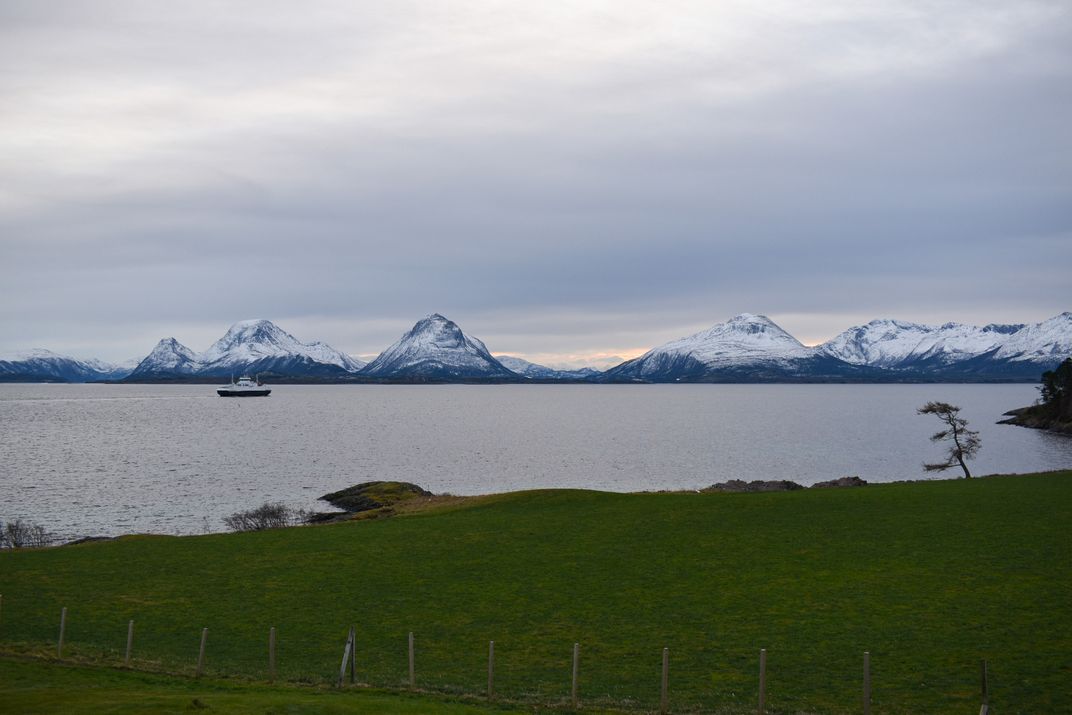
Farther out along the heath, a panoramic view encompasses the straits leading north toward Trondheim and the steep, spiky mountains on the island of Tustna across the straits. As we track ferries and an occasional cruise ship sailing past, Blakstad, with sweeping gestures, expounds on the Berlin team’s claim and why it all makes so much sense when seen from up close, from the very spot where Pytheas himself might have admired the sun skimming the horizon.
Pytheas, says Blakstad, would have wanted a sheltered route to explore the coast. An ideal natural route is provided by the straits (“the fairway” as it’s called locally). Trade routes along the straits may have been in existence since the Bronze Age. Those steep, spiky mountains across the fairway serve as a distinctive, even dramatic, landmark. Vikings knew the route well. The mountains signal the location of the coves just across the way in Kuli. Blakstad points down toward one such cove, tranquil and easily accessible.
“Yes, but—,” I begin, thinking of the Icelandic counterclaims. Blakstad cuts me short. “If it had been me,” he says, “and I’d ventured into open ocean from the north of Britain, as I’ve done, and I was hoping to explore unknown territory to the north, this is the route I would have chosen.” With sonorous emphasis, he adds, “And I’m a navigator.”
This article is from Hakai Magazine, an online publication about science and society in coastal ecosystems. Read more stories like this at hakaimagazine.com.
More stories from Hakai Magazine:
Planning Your Next Trip?
Explore great travel deals
Smithsonian magazine participates in affiliate link advertising programs. If you purchase an item through these links, we receive a commission.
/https://tf-cmsv2-smithsonianmag-media.s3.amazonaws.com/filer/08/e7/08e74aa9-82f8-4a51-ae70-a50487951598/smola_norway-mobile.jpg)
/https://tf-cmsv2-smithsonianmag-media.s3.amazonaws.com/filer/b6/90/b690c7d6-210f-4204-b89d-b6ed3e8d3fe2/smola_norway_header.jpg)